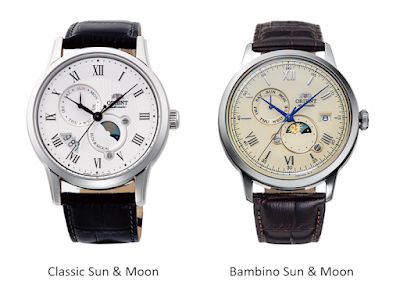Before wrapping up my time with the Mako 40 and returning it to Orient,
I thought it might be interesting to see how it fares against a comparable dive
watch, at a similar price range, from a different Japanese brand. Enter the
Citizen Promaster!
Specifically, I'm looking at the Godzilla limited edition, ref.
NY0080-21z. I picked it from my personal collection, and as it is of the older,
42mm case models, which are closer in size to the Mako. Note that newer Promaster
automatic divers (NY015x series) look very similar but have a 44mm case.
Despite the wider case on paper, the two watches are very similar in how
they are worn. The Mako is slightly shorter at 46.5mm lug to lug, compared to the
Citizen's 47.5mm, both are about the same 12.8mm thickness and same lug width
of 20mm.
Visually the Promaster looks a bit smaller than its 42mm, as the bezel
is slightly narrower than the case; likewise the Mako looks a little bigger
than its 40mm width, thanks to the visual impact of the steel bezel, and the
greater volume occupied by its lugs – compared to the Citizen's.
In terms of styling, the two watches take quite a different approach to
the dive concept. The Orient has more flat surfaces and a simpler design
language. With its rectangular markers and hands, and raw steel bezel, it looks
like a tool watch first, and a diver second. The Citizen is more rounded, like
a pebble, and includes some more elaborate shapes among its hands and markers
(and I'll ignore the Godzilla dial for now…)
Personally, I do like the Mako style, and particularly the finishing, a
bit more. I find Orient's choices of where to have it brushed and where polish the case bright, quite appreciable.
Technically, too, there are some clear differences between the watches.
The crown of the Citizen is easier to handle – it is bigger and screws /
unscrews more smoothly; on the other hand, it is left-sided, which makes
setting the time a little confusing (I hold it upside down for that purpose),
and while setting the time is smooth, changing the day and date feel a little
plasticky compared to the Mako. It's kind of a draw here, really.
The Mako has a sapphire crystal, while this Promaster uses mineral
crystal. I believe the new 44mm Promasters use sapphire as well, as do some
Fugu versions of the older 42mm Promasters, but here's it mineral.
Legibility is very similar; both watches stick to the dive watch dial
rulebook that dictates large, lumed indices and hands. There's no clear winner
here, they're both really good. However, for those who care about diving
functionality, the lumed pip on the Citizen bezel might gain an extra point.
On the subject of diving, note that while the Orient is just a
"diver style" watch, as Orient puts it, the Citizen is a true diver
with 200m rating. This difference is also apparent in the brand's choice of
bands. While both watchmakers offer steel bracelets for these models, Orient's
other strap of choice for the Mako 40 is leather – while Citizen's is a rubber
band. Mind you, I found the Citizen rubber to be too tough and uncomfortable,
so I switched it to an Uncle strap. I did not try Orient's rubber with the
likes of Kamasu and Mako 42, but the rubber on both OS Diver and M-Force is
considerably better than the Promaster's.
Bezel action on the Citizen requires less force than the Orient's but is
equally accurate with very little backplay. I guess those who just like to
fiddle with the bezel would prefer the Promaster, while those who seek a very
secure bezel would prefer the Mako – despite this possibly going against their
diver/non-diver orientations.
In terms of accuracy, my Mako measured +11 s/d deviation – while the
Citizen does -3 s/d. Better accuracy from the Citizen 8204 then, however, many
would prefer a watch running slightly faster than slower. The Orient movement's
overall better specs (+25/-15 vs. +40/-20) indicates it might also be easier to
regulate to higher accuracy.
So these are both pretty good watches for their 300-400 USD range, with
different but comparable specs and characteristics. I admit to liking the Mako
styling better (though I like the Godzilla dial on this particular limited
edition Promaster). I feel like while objectively the Citizen might have the
slightly upper hand in technical specs, somehow it's the Orient that gives a
tougher and more capable impression. I do believe the objective differences are
small enough to justify whichever of the two you subjectively prefer.



























